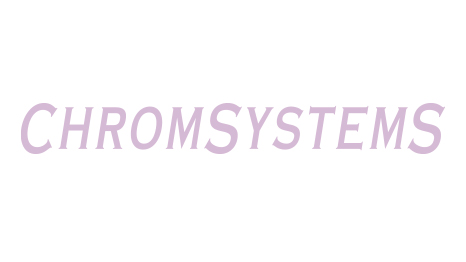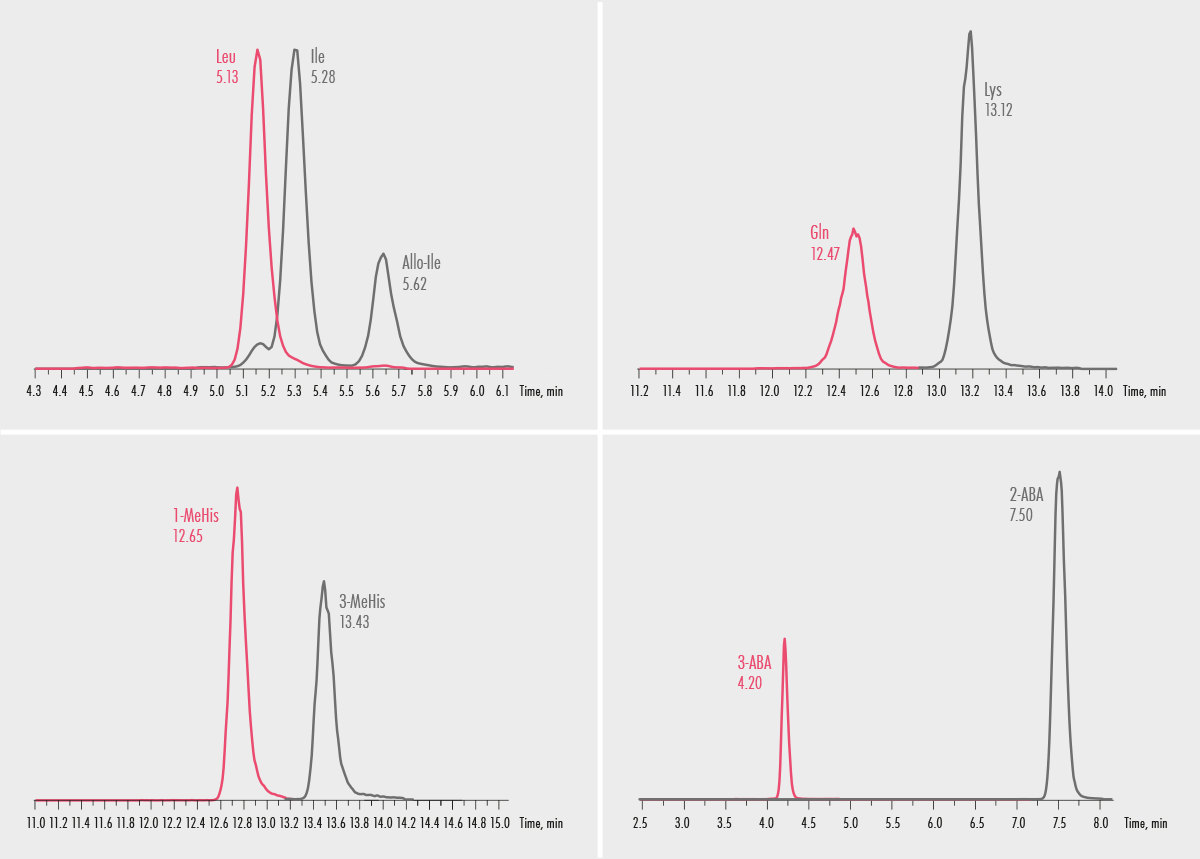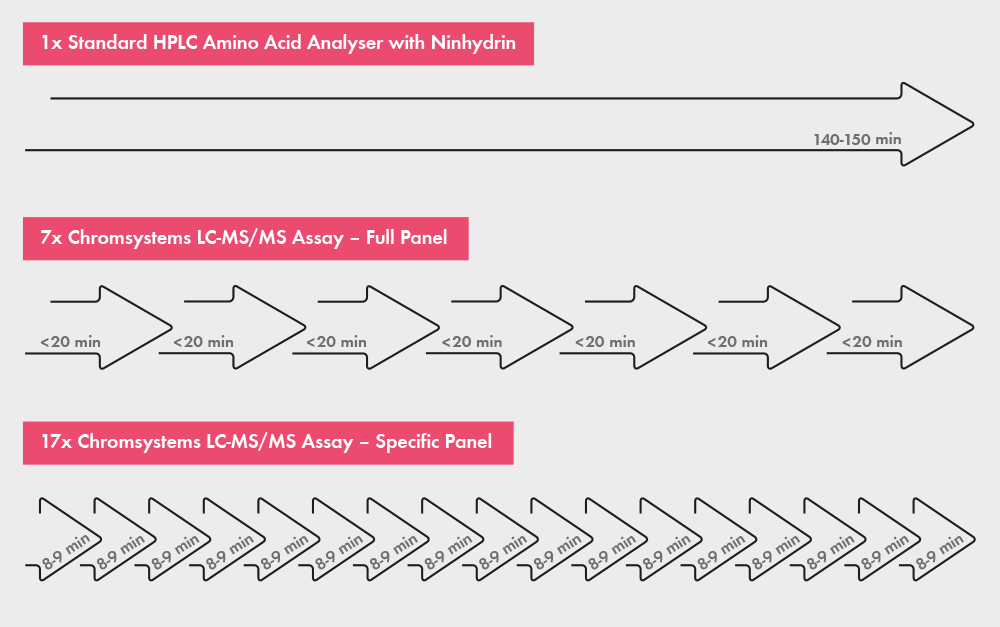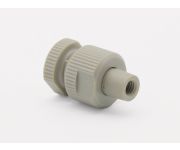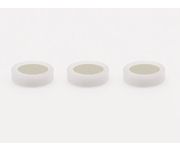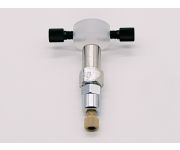MassChrom® Amino Acid Analysis in Plasma/Serum with 96 Deep Well Plate - LC-MS/MS
Quantitative analysis of 48 amino acids
No derivatisation
Short run times
Excellent separation of isobaric analytes
Each analyte safeguarded by its own internal standard




| Acetyltyrosine Adenosylhomocysteine Alanine β-Alanine α-Aminoadipic acid α-Aminobutyric acid β-Aminoisobutyric acid γ-Aminobutyric acid Anserine Arginine Argininosuccinic acid Asparagine |
Aspartic acid Carnosine Citrulline Homocitrulline Cystathionine Cystine Cysteine sulfate Homocystine Ethanolamine Phosphoethanolamine Glutamic acid Glutamine |
Glycine Histidine 1-Methylhistidine 3-Methylhistidine Leucine Isoleucine Allo-Isoleucine Lysine Hydroxylysine Methionine Ornithine Phenylalanine |
Phosphoserine Pipecolic acid Proline 4-Hydroxyproline Saccharopine Sarcosine Serine Taurine Threonine Tryptophan Tyrosine Valine |
The 7 analytes highlighted in red can be measured with both the full panel and the specific panel.
This assay is designed for the quantitative determination of amino acids in plasma/serum by LC-MS/MS. The method covers 48 amino acids and derivatives that are analysed within 20 min in one single run. Alternatively, the same assay allows the determination of 7 specific analytes in a much shorter run time (8-9 min) using a modified gradient. Both panels use the identical chromatographic set up, research sample preparation procedure, 3PLUS1® Multilevel Calibrator Set and MassCheck® Controls. In addition, each of the 48 analytes is safeguarded by an own internal standard. The assay is available in 2 configurations, either with reaction vials or with 96 deep well plates.
| Method of Analysis | LC-MS/MS |
|---|---|
| Number of Tests | 3 x 96 |
| Please note | The freely available information on this website, in particular on the sample preparation, are not sufficient to work with our products. Please read instructions and warning notices on products and/or instruction manuals. |
| Specimen | Plasma/Serum |
| Sample Preparation |
|
| Injection Volume | 2–5 μl |
| Column Temperature | + 25 °C |
| Gradient | binary, flow gradient (Full Panel) |
| Ionisation | ESI positive |
| MS/MS Mode | MRM |
| Parameters | Amino Acids |
-
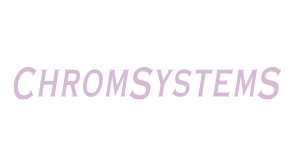 Internal Standard Set Amino Acid AnalysisOrder no.: 75146/RUO
Internal Standard Set Amino Acid AnalysisOrder no.: 75146/RUOMassChrom® Amino Acid Analysis in Plasma/Serum - LC-MS/MS
-
 Precipitation ReagentOrder no.: 75105/RUO
Precipitation ReagentOrder no.: 75105/RUOMassChrom® Amino Acid Analysis in Plasma/Serum - LC-MS/MS
-
 Pierceable Heat Seals for 96 Well PlatesOrder no.: 75060/RUO
Pierceable Heat Seals for 96 Well PlatesOrder no.: 75060/RUOMassChrom® Amino Acid Analysis in Plasma/Serum - LC-MS/MS
-
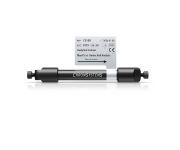 Analytical Column Amino Acid Analysis - LC-MS/MSOrder no.: 75100MassChrom® Amino Acid Analysis in Plasma/Serum or Urine - LC-MS/MS
Analytical Column Amino Acid Analysis - LC-MS/MSOrder no.: 75100MassChrom® Amino Acid Analysis in Plasma/Serum or Urine - LC-MS/MS -
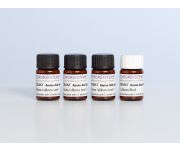 3PLUS1® Multilevel Plasma Calibrator Set Amino Acid AnalysisOrder no.: 75128MassChrom® Amino Acid Analysis in Plasma/Serum - LC-MS/MS
3PLUS1® Multilevel Plasma Calibrator Set Amino Acid AnalysisOrder no.: 75128MassChrom® Amino Acid Analysis in Plasma/Serum - LC-MS/MS -
 MassCheck® Amino Acid Analysis Plasma ControlsOrder no.: 0471/0472/0473MassChrom® Amino Acid Analysis in Plasma/Serum – LC-MS/MS
MassCheck® Amino Acid Analysis Plasma ControlsOrder no.: 0471/0472/0473MassChrom® Amino Acid Analysis in Plasma/Serum – LC-MS/MS -
 Tuning Mix 1 Amino Acid AnalysisOrder no.: 75015/RUO
Tuning Mix 1 Amino Acid AnalysisOrder no.: 75015/RUOMassChrom® Amino Acid Analysis in Plasma/Serum - LC-MS/MS
-
 Tuning Mix 2 Amino Acid AnalysisOrder no.: 75016/RUO
Tuning Mix 2 Amino Acid AnalysisOrder no.: 75016/RUOMassChrom® Amino Acid Analysis in Plasma/Serum - LC-MS/MS
-
 Tuning Mix 3 Amino Acid AnalysisOrder no.: 75017/RUO
Tuning Mix 3 Amino Acid AnalysisOrder no.: 75017/RUOMassChrom® Amino Acid Analysis in Plasma/Serum - LC-MS/MS
-
 Tuning Mix 4 Amino Acid AnalysisOrder no.: 75018/RUO
Tuning Mix 4 Amino Acid AnalysisOrder no.: 75018/RUOMassChrom® Amino Acid Analysis in Plasma/Serum - LC-MS/MS
-
 Tuning Mix 5 Amino Acid AnalysisOrder no.: 75019/RUO
Tuning Mix 5 Amino Acid AnalysisOrder no.: 75019/RUOMassChrom® Amino Acid Analysis in Plasma/Serum - LC-MS/MS
-
 3PLUS1® Multilevel Plasma Calibrator Set Amino Acid AnalysisOrder no.: 75128MassChrom® Amino Acid Analysis in Plasma/Serum - LC-MS/MS
3PLUS1® Multilevel Plasma Calibrator Set Amino Acid AnalysisOrder no.: 75128MassChrom® Amino Acid Analysis in Plasma/Serum - LC-MS/MS
-
 MassCheck® Amino Acid Analysis Plasma ControlsOrder no.: 0471/0472/0473MassChrom® Amino Acid Analysis in Plasma/Serum – LC-MS/MS
MassCheck® Amino Acid Analysis Plasma ControlsOrder no.: 0471/0472/0473MassChrom® Amino Acid Analysis in Plasma/Serum – LC-MS/MS
-
 Analytical Column Amino Acid Analysis - LC-MS/MSOrder no.: 75100MassChrom® Amino Acid Analysis in Plasma/Serum or Urine - LC-MS/MS
Analytical Column Amino Acid Analysis - LC-MS/MSOrder no.: 75100MassChrom® Amino Acid Analysis in Plasma/Serum or Urine - LC-MS/MS
-
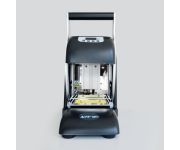 Heat SealerOrder no.: 42740
Heat SealerOrder no.: 42740Easy sealing of 96 well plates
Adjustable time and temperature
Ergonomic lever
Compatible with a wide range of microplates
Fast start-up
Small footprint




| Acetyltyrosine Adenosylhomocysteine Alanine β-Alanine α-Aminoadipic acid α-Aminobutyric acid β-Aminoisobutyric acid γ-Aminobutyric acid Anserine Arginine Argininosuccinic acid Asparagine |
Aspartic acid Carnosine Citrulline Homocitrulline Cystathionine Cystine Cysteine sulfate Homocystine Ethanolamine Phosphoethanolamine Glutamic acid Glutamine |
Glycine Histidine 1-Methylhistidine 3-Methylhistidine Leucine Isoleucine Allo-Isoleucine Lysine Hydroxylysine Methionine Ornithine Phenylalanine |
Phosphoserine Pipecolic acid Proline 4-Hydroxyproline Saccharopine Sarcosine Serine Taurine Threonine Tryptophan Tyrosine Valine |
The 7 analytes highlighted in red can be measured with both the full panel and the specific panel.
This assay is designed for the quantitative determination of amino acids in plasma/serum by LC-MS/MS. The method covers 48 amino acids and derivatives that are analysed within 20 min in one single run. Alternatively, the same assay allows the determination of 7 specific analytes in a much shorter run time (8-9 min) using a modified gradient. Both panels use the identical chromatographic set up, research sample preparation procedure, 3PLUS1® Multilevel Calibrator Set and MassCheck® Controls. In addition, each of the 48 analytes is safeguarded by an own internal standard. The assay is available in 2 configurations, either with reaction vials or with 96 deep well plates.
| Method of Analysis | LC-MS/MS |
|---|---|
| Number of Tests | 3 x 96 |
| Please note | The freely available information on this website, in particular on the sample preparation, are not sufficient to work with our products. Please read instructions and warning notices on products and/or instruction manuals. |
| Specimen | Plasma/Serum |
| Sample Preparation |
|
| Injection Volume | 2–5 μl |
| Column Temperature | + 25 °C |
| Gradient | binary, flow gradient (Full Panel) |
| Ionisation | ESI positive |
| MS/MS Mode | MRM |
| Parameters | Amino Acids |
-
 Internal Standard Set Amino Acid AnalysisOrder no.: 75146/RUO
Internal Standard Set Amino Acid AnalysisOrder no.: 75146/RUOMassChrom® Amino Acid Analysis in Plasma/Serum - LC-MS/MS
-
 Precipitation ReagentOrder no.: 75105/RUO
Precipitation ReagentOrder no.: 75105/RUOMassChrom® Amino Acid Analysis in Plasma/Serum - LC-MS/MS
-
 Pierceable Heat Seals for 96 Well PlatesOrder no.: 75060/RUO
Pierceable Heat Seals for 96 Well PlatesOrder no.: 75060/RUOMassChrom® Amino Acid Analysis in Plasma/Serum - LC-MS/MS
-
 Analytical Column Amino Acid Analysis - LC-MS/MSOrder no.: 75100MassChrom® Amino Acid Analysis in Plasma/Serum or Urine - LC-MS/MS
Analytical Column Amino Acid Analysis - LC-MS/MSOrder no.: 75100MassChrom® Amino Acid Analysis in Plasma/Serum or Urine - LC-MS/MS -
 3PLUS1® Multilevel Plasma Calibrator Set Amino Acid AnalysisOrder no.: 75128MassChrom® Amino Acid Analysis in Plasma/Serum - LC-MS/MS
3PLUS1® Multilevel Plasma Calibrator Set Amino Acid AnalysisOrder no.: 75128MassChrom® Amino Acid Analysis in Plasma/Serum - LC-MS/MS -
 MassCheck® Amino Acid Analysis Plasma ControlsOrder no.: 0471/0472/0473MassChrom® Amino Acid Analysis in Plasma/Serum – LC-MS/MS
MassCheck® Amino Acid Analysis Plasma ControlsOrder no.: 0471/0472/0473MassChrom® Amino Acid Analysis in Plasma/Serum – LC-MS/MS -
 Tuning Mix 1 Amino Acid AnalysisOrder no.: 75015/RUO
Tuning Mix 1 Amino Acid AnalysisOrder no.: 75015/RUOMassChrom® Amino Acid Analysis in Plasma/Serum - LC-MS/MS
-
 Tuning Mix 2 Amino Acid AnalysisOrder no.: 75016/RUO
Tuning Mix 2 Amino Acid AnalysisOrder no.: 75016/RUOMassChrom® Amino Acid Analysis in Plasma/Serum - LC-MS/MS
-
 Tuning Mix 3 Amino Acid AnalysisOrder no.: 75017/RUO
Tuning Mix 3 Amino Acid AnalysisOrder no.: 75017/RUOMassChrom® Amino Acid Analysis in Plasma/Serum - LC-MS/MS
-
 Tuning Mix 4 Amino Acid AnalysisOrder no.: 75018/RUO
Tuning Mix 4 Amino Acid AnalysisOrder no.: 75018/RUOMassChrom® Amino Acid Analysis in Plasma/Serum - LC-MS/MS
-
 Tuning Mix 5 Amino Acid AnalysisOrder no.: 75019/RUO
Tuning Mix 5 Amino Acid AnalysisOrder no.: 75019/RUOMassChrom® Amino Acid Analysis in Plasma/Serum - LC-MS/MS
-
 3PLUS1® Multilevel Plasma Calibrator Set Amino Acid AnalysisOrder no.: 75128MassChrom® Amino Acid Analysis in Plasma/Serum - LC-MS/MS
3PLUS1® Multilevel Plasma Calibrator Set Amino Acid AnalysisOrder no.: 75128MassChrom® Amino Acid Analysis in Plasma/Serum - LC-MS/MS
-
 MassCheck® Amino Acid Analysis Plasma ControlsOrder no.: 0471/0472/0473MassChrom® Amino Acid Analysis in Plasma/Serum – LC-MS/MS
MassCheck® Amino Acid Analysis Plasma ControlsOrder no.: 0471/0472/0473MassChrom® Amino Acid Analysis in Plasma/Serum – LC-MS/MS
-
 Analytical Column Amino Acid Analysis - LC-MS/MSOrder no.: 75100MassChrom® Amino Acid Analysis in Plasma/Serum or Urine - LC-MS/MS
Analytical Column Amino Acid Analysis - LC-MS/MSOrder no.: 75100MassChrom® Amino Acid Analysis in Plasma/Serum or Urine - LC-MS/MS
-
 Heat SealerOrder no.: 42740
Heat SealerOrder no.: 42740Easy sealing of 96 well plates
Adjustable time and temperature
Ergonomic lever
Compatible with a wide range of microplates
Fast start-up
Small footprint

